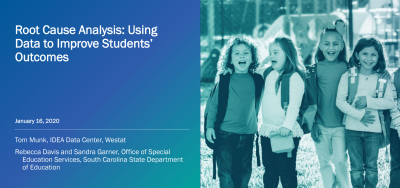Site Search
Results 1 - 4 of 4
-
Root Cause Analysis: Using Data to Improve Students' Outcomes
This webinar helped states and local education agencies (LEAs) learn how to use root cause analysis to analyze their 616 and 618 data and use the results to improve student outcomes. States and LEAs should conduct a root cause analysis when these data show that some groups of students are succeeding at lower rates than other groups are. Presenters discussed how to perform a successful root cause analysis in order to identify why performance or achievement gaps are happening and prevent them from reoccurring. Staff from the South Carolina Department of Education presented on the state’s use of the IDC Success Gaps Toolkit for root cause analysis with LEAs and the solutions the LEAs implemented as a result of their analyses.
Format: Guides and Briefs
Success Gaps Rubric: Addressing Equity, Inclusion, and OpportunityThis rubric allows a team of users from a district or school to systematically examine the root causes of success gaps among groups of students by focusing on equity, inclusion, and opportunity. The recently updated rubric now includes considerations for children as young as preschool age. A complementary white paper provided the research-based background that supported development of the rubric.
Format: Toolkits
Success Gaps Toolkit: Addressing Equity, Inclusion, and OpportunityThe Success Gaps Toolkit presents a process for using data and the Success Gap Rubric to identify root causes of gaps between groups of children in districts or schools. These success gaps occur when the education system is not meeting the needs of all groups of children and outcomes for some groups are different than outcomes for most groups. The toolkit, with its process and materials, provides a manageable and defined way for districts or schools to identify success gaps that are present and their root causes and then make a plan for addressing the gaps. The success gaps may be the graduation rate of students who are English learners compared to the rate of all other children, the out-of-school suspension rate of children who are Black compared to the rate of all other children, the identification of children who are Hispanic as children with specific learning disabilities compared to the identification of all other children, and other gaps.
Format: Guides and Briefs
Examining Representation and Identification: Over, Under, or Both?Significant disproportionality with regard to identifying children as children with disabilities or as children with specific disabilities is, by definition, overrepresentation. This resource defines overrepresentation and three related terms: over-identification, under-identification, and underrepresentation. States can use this resource, in conjunction with the Success Gaps Toolkit to help identify and address the factors contributing to significant disproportionality (i.e., overrepresentation) within school districts.




